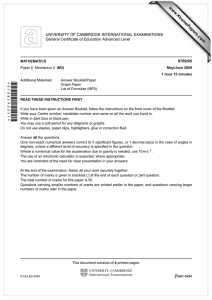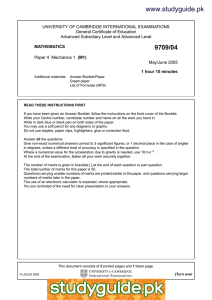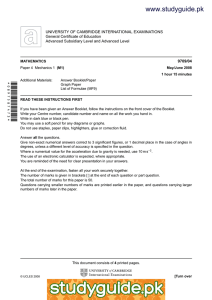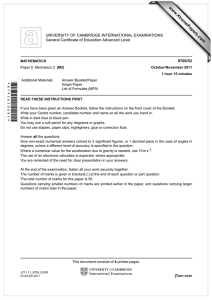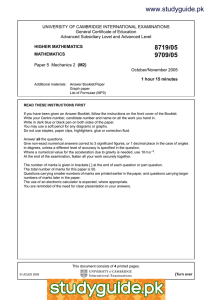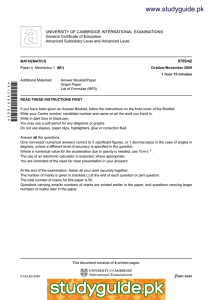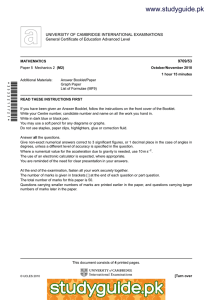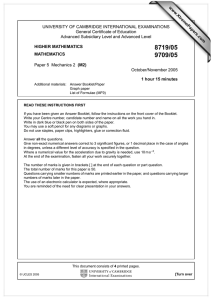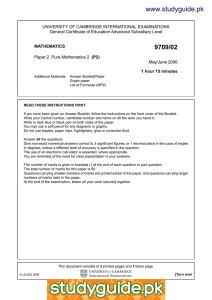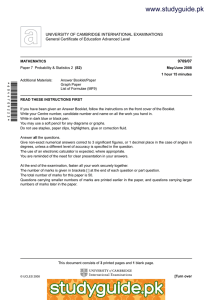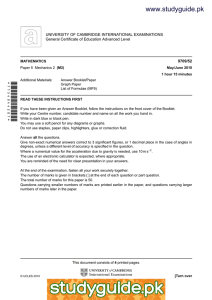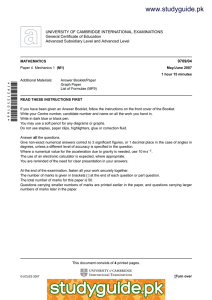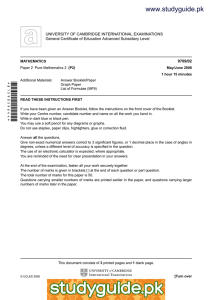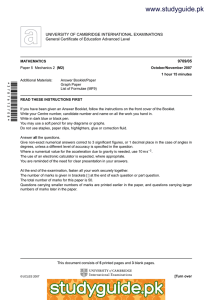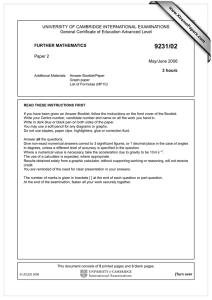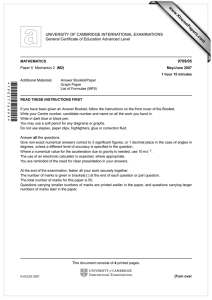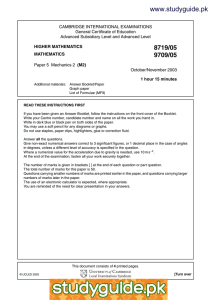www.studyguide.pk * 0 7
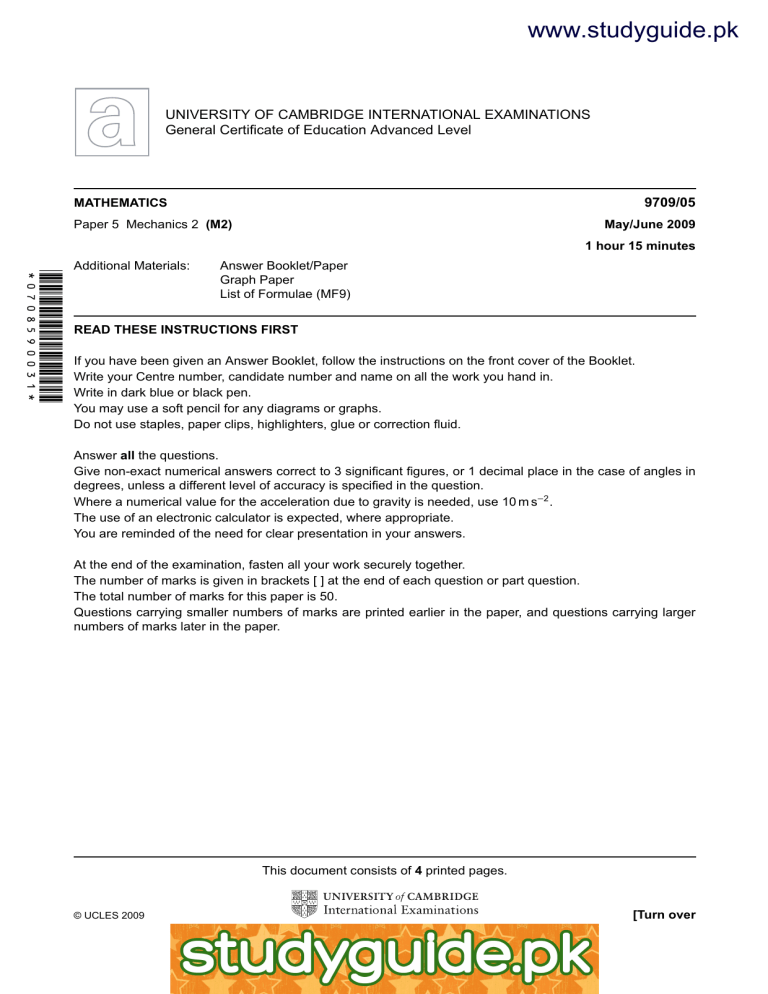
www.studyguide.pk
UNIVERSITY OF CAMBRIDGE INTERNATIONAL EXAMINATIONS
General Certificate of Education Advanced Level
MATHEMATICS
Paper 5 Mechanics 2 (M2)
9709/05
May/June 2009
1 hour 15 minutes
Additional Materials: Answer Booklet/Paper
Graph Paper
List of Formulae (MF9)
READ THESE INSTRUCTIONS FIRST
If you have been given an Answer Booklet, follow the instructions on the front cover of the Booklet.
Write your Centre number, candidate number and name on all the work you hand in.
Write in dark blue or black pen.
You may use a soft pencil for any diagrams or graphs.
Do not use staples, paper clips, highlighters, glue or correction fluid.
Answer all the questions.
Give non-exact numerical answers correct to 3 significant figures, or 1 decimal place in the case of angles in degrees, unless a different level of accuracy is specified in the question.
Where a numerical value for the acceleration due to gravity is needed, use 10 m s −
2
.
The use of an electronic calculator is expected, where appropriate.
You are reminded of the need for clear presentation in your answers.
At the end of the examination, fasten all your work securely together.
The number of marks is given in brackets [ ] at the end of each question or part question.
The total number of marks for this paper is 50.
Questions carrying smaller numbers of marks are printed earlier in the paper, and questions carrying larger numbers of marks later in the paper.
© UCLES 2009
This document consists of 4 printed pages.
www.xtremepapers.net
[Turn over
2 www.studyguide.pk
2
1 A uniform lamina is in the form of a sector of a circle with centre O , radius 0.2 m and angle 1.5 radians.
The lamina rotates in a horizontal plane about a fixed vertical axis through O . The centre of mass of the lamina moves with speed 0.4 m s −
1
. Show that the angular speed of the lamina is 3.30 rad s −
1
, correct to 3 significant figures.
[4]
C
A
10 cm
O
G
B
AB is a diameter of a uniform solid hemisphere with centre O , radius 10 cm and weight 12 N. One end of a light inextensible string is attached to the hemisphere at B and the other end is attached to a fixed point C of a vertical wall. The hemisphere is in equilibrium with A in contact with the wall at a point vertically below C . The centre of mass G of the hemisphere is at the same horizontal level as
A , and angle ABC is a right angle (see diagram). Calculate the tension in the string.
[4]
3 A particle P starts from a fixed point O and moves in a straight line. When the displacement of P from O is x m, its velocity is v m s −
1 and its acceleration is
1 x
+
2 m s
−
2
.
(i) Given that v
=
2 when x
=
0, use integration to show that v
2
=
2 ln
1
2 x
+
1
+
4.
(ii) Find the value of v when the acceleration of P is
1
4 m s −
2
.
[4]
[2]
© UCLES 2009 9709/05/M/J/09 www.xtremepapers.net
www.studyguide.pk
3
4
0.5 m
0.3 m
A particle of mass 0.12 kg is moving on the smooth inside surface of a fixed hollow sphere of radius
0.5 m. The particle moves in a horizontal circle whose centre is 0.3 m below the centre of the sphere
(see diagram).
(i) Show that the force exerted by the sphere on the particle has magnitude 2 N.
(ii) Find the speed of the particle.
(iii) Find the time taken for the particle to complete one revolution.
[2]
[3]
[2]
5 A small stone is projected from a point O on horizontal ground with speed V m s −
1 at an angle θ ◦ above the horizontal. Referred to horizontal and vertically upwards axes through O , the equation of the stone’s trajectory is y
=
0.75
x
−
0.02
x
2
, where x and y are in metres. Find
(i) the values of θ and V , [4]
(ii) the distance from O of the point where the stone hits the ground,
(iii) the greatest height reached by the stone.
[2]
[2]
6
A
P
M
2 m
B
A particle P of mass 1.6 kg is attached to one end of each of two light elastic strings. The other ends of the strings are attached to fixed points A and B which are 2 m apart on a smooth horizontal table. The string attached to A has natural length 0.25 m and modulus of elasticity 4 N, and the string attached to
B has natural length 0.25 m and modulus of elasticity 8 N. The particle is held at the mid-point M of
AB (see diagram).
(i) Find the tensions in the strings.
[2]
(ii) Show that the total elastic potential energy in the two strings is 13.5 J.
[2]
P is released from rest and in the subsequent motion both strings remain taut. The displacement of P from M is denoted by x m. Find
(iii) the initial acceleration of P ,
(iv) the non-zero value of x at which the speed of P is zero.
[2]
[4]
© UCLES 2009
[Turn over
9709/05/M/J/09 www.xtremepapers.net
www.studyguide.pk
7
B
2 cm
4
10 cm
O
2 cm
A
8 cm
Fig. 1
A uniform solid body has a cross-section as shown in Fig. 1.
(i) Show that the centre of mass of the body is 2.5 cm from the plane face containing OB and 3.5 cm from the plane face containing OA .
[4]
(ii) The solid is placed on a rough plane which is initially horizontal. The coefficient of friction between the solid and the plane is µ .
(a)
B
(b)
A
O
Fig. 2
The solid is placed with OA in contact with the plane, and then the plane is tilted so that
OA lies along a line of greatest slope with A higher than O (see Fig. 2). When the angle of inclination is sufficiently great the solid starts to topple (without sliding). Show that µ
>
5
.
7
[5]
A
B
O
Fig. 3
Instead, the solid is placed with OB in contact with the plane, and then the plane is tilted so that OB lies along a line of greatest slope with B higher than O (see Fig. 3). When the angle of inclination is sufficiently great the solid starts to slide (without toppling). Find another inequality for µ .
[2]
Permission to reproduce items where third-party owned material protected by copyright is included has been sought and cleared where possible. Every reasonable effort has been made by the publisher (UCLES) to trace copyright holders, but if any items requiring clearance have unwittingly been included, the publisher will be pleased to make amends at the earliest possible opportunity.
University of Cambridge International Examinations is part of the Cambridge Assessment Group. Cambridge Assessment is the brand name of University of
Cambridge Local Examinations Syndicate (UCLES), which is itself a department of the University of Cambridge.
© UCLES 2009 9709/05/M/J/09 www.xtremepapers.net
